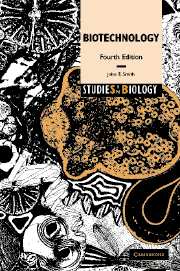Book contents
- Frontmatter
- Contents
- Preface
- 1 The nature of biotechnology
- 2 Substrates for biotechnology
- 3 Genetics and biotechnology
- 4 Bioprocess/fermentation technology
- 5 Enzyme technology
- 6 Biological fuel generation
- 7 Single cell protein (SCP)
- 8 Biotechnology and medicine
- 9 Environmental biotechnology
- 10 Biotechnology in the agricultural and forestry industries
- 11 Food and beverage biotechnology
- 12 Protection of biotechnological inventions
- 13 Safety in biotechnology
- 14 Public perception of biotechnology: genetic engineering – safety, social, moral and ethical considerations
- 15 Looking to the future
- Glossary
- Further reading
- Index
13 - Safety in biotechnology
Published online by Cambridge University Press: 05 June 2012
- Frontmatter
- Contents
- Preface
- 1 The nature of biotechnology
- 2 Substrates for biotechnology
- 3 Genetics and biotechnology
- 4 Bioprocess/fermentation technology
- 5 Enzyme technology
- 6 Biological fuel generation
- 7 Single cell protein (SCP)
- 8 Biotechnology and medicine
- 9 Environmental biotechnology
- 10 Biotechnology in the agricultural and forestry industries
- 11 Food and beverage biotechnology
- 12 Protection of biotechnological inventions
- 13 Safety in biotechnology
- 14 Public perception of biotechnology: genetic engineering – safety, social, moral and ethical considerations
- 15 Looking to the future
- Glossary
- Further reading
- Index
Summary
Introduction
In previous chapters the many applications of biotechnology can be divided into the traditional domains of fermentation for the production of various potable beverages, bread, cheese, organic acids, antibiotics and waste treatment, and the new biotechnologies, including production and use of genetically modified organisms for the large-scale production of vaccines, therapeutic proteins and other health products, together with the use of hybridomas for the production of monoclonal antibodies for diagnostic and therapeutic end-points. As such, biotechnology spans a vast range of industrial activities, and considerations of biosafety can potentially encompass activities within the research laboratory, the process plant, the final product and, in many cases, the environment. The term ‘biosafety’ has evolved as a new area of corporate activity created as an inevitable response generated by an expanding biotechnology industry and its increasing influence upon may aspects of commercial and public life. In particular, the many public issues recently generated, especially in Europe, concerning genetically modified crop trials have done much to raise the profile of this subject.
In all biotechnology processes, however, safety is of paramount importance. Table 13.1 lists the main areas of consideration for safety aspects in biotechnology.
Concepts of hazard and risk
Essential to the understanding of biosafety are the recognition and appreciation of the terms ‘hazard’ and ‘risk’. In the context of health and safety, ‘hazard’ can be a substance, object or situation with a potential for an accident or damage, and ‘risk’ is the likelihood that this will occur (Table 13.2).
- Type
- Chapter
- Information
- Biotechnology , pp. 235 - 240Publisher: Cambridge University PressPrint publication year: 2004



